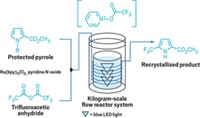Advertisement
Grab your lab coat. Let's get started
Welcome!
Welcome!
Create an account below to get 6 C&EN articles per month, receive newsletters and more - all free.
It seems this is your first time logging in online. Please enter the following information to continue.
As an ACS member you automatically get access to this site. All we need is few more details to create your reading experience.
Not you? Sign in with a different account.
Not you? Sign in with a different account.
ERROR 1
ERROR 1
ERROR 2
ERROR 2
ERROR 2
ERROR 2
ERROR 2
Password and Confirm password must match.
If you have an ACS member number, please enter it here so we can link this account to your membership. (optional)
ERROR 2
ACS values your privacy. By submitting your information, you are gaining access to C&EN and subscribing to our weekly newsletter. We use the information you provide to make your reading experience better, and we will never sell your data to third party members.
Synthesis
Sodium Borohydride Goes With The Flow
Common reducing agent is used in a flow-through column to scale up synthesis of alcohols and amines
by Stephen K. Ritter
November 24, 2014
| A version of this story appeared in
Volume 92, Issue 47
Sodium borohydride has been a go-to reagent for carrying out selective reductions of aldehydes and ketones to alcohols for 60 years. But in a new development involving the old standard, a research team led by Kerry Gilmore and Peter H. Seeberger of the Max Planck Institute of Colloids & Interfaces have used solid NaBH4 mixed with LiCl and the filtration medium Celite (diatomaceous earth) to carry out reductions in a flow reactor system (Org. Process Res. Dev. 2014, DOI: 10.1021/op500310s). The development offers a continuous, gram-scale process that matches the reaction efficiency of batch methods. The work stems from an earlier effort by Seeberger’s group to find an inexpensive way to reduce artemisinin during the synthesis of the antimalarial drugs artesunate, artemether, and artemotil. Seeberger cofounded the company ArtemiFlow to commercialize a flow-through reaction system to produce the drugs. After using NaBH4 in one step of the artemisinin flow synthesis, the researchers realized it might be useful for other continuous reductions. In the new report, they describe using a NaBH4 column for reductions of a variety of aldehydes and ketones to alcohols as well as reductions of in situ-generated imines to form amines.




Join the conversation
Contact the reporter
Submit a Letter to the Editor for publication
Engage with us on Twitter